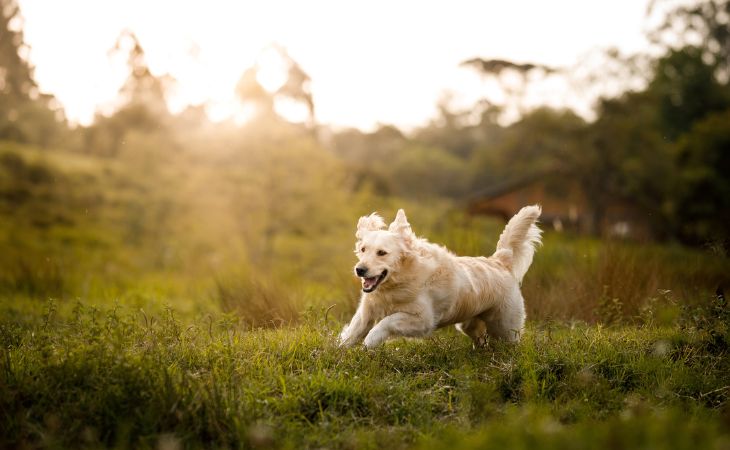Just like humans, dogs are able to feel emotions and express them in various ways. Sometimes it can look like dogs are smiling when they open their mouth and show their teeth? But is that really a smile? Well, it depends on the dog and the situation. In this article, we will teach you how to recognize your dog’s smile and understand how they are actually feeling.
Can dogs really smile?
When dogs express their emotions, they release certain hormones that produce chemical changes in their bodies. For example, with the production of oxytocin, which is also known as the “love hormone”.
Unlike humans, dogs do not show all their teeth or fully curl their lips when they smile. Instead, they generally do this when they are faced with danger or a threat. They might also growl, have a stiff posture, or have raised hair on their back or neck.
When dogs smile, they slightly open their mouth to show their teeth and contract their lips. They relax their facial muscles and their posture. This body language typically shows that your dog is in a positive emotional state.
As mentioned earlier, dogs don’t really copy the smile of their owners. With that being said, they can be encouraged to show happiness when their owner smiles. According to most researchers, dogs smile due to a combination of evolution and their ability to understand human behavior.
What does it mean if my dog smiles?
Just like humans, dogs can express different emotions when they smile. To understand the emotional state of a smiling dog, you need to take a good look at its overall body language.
A sign of acceptance and friendship
When a dog is feeling at ease and happy, they can open their mouth and leave their tongue hanging. This behavior generally shows consent and they might do this when they are being petted. In other words, your dog is indicating to you that they feel safe with you. In addition, to further show their acceptance and friendliness, they might try to get closer to you and search for physical contact.
Submission
It’s also possible for a dog to smile to show submission. If this is the case, your dog might lie down on their back and expose their belly. Additionally, they might lower their head and avoid direct eye contact with you. Some dogs can even lick their lips or even urinate when they are showing submission.
They might do this simply as a way to communicate that they recognize your authority or that they wish to avoid conflict. Some dogs are naturally more inclined to show submissive behavior, while others do so less frequently.
An invitation to play
When dogs invite others to play, they can present specific behaviors accompanied with a smile to communicate their desire to have fun and interact.
An example of a situation where a dog might do this is when the dog sees one of their friends on a walk or at the park. If the dog likes you and wants to play with you, they may smile and adopt a playful posture by bending forward and wagging their tail. With that being said, their body will be relaxed while at the same time, ready to get moving.
When dogs have a lot of energy and want to play, they can also lift their behind, jump, and run around everywhere. Some dogs even use head movements, such as nodding. Dogs that want to play can touch you with their paws to encourage you to play.
A soft growl without aggressiveness is sometimes a way for dogs to show that they are ready to play.
Dogs have many wats of expressing their good mood.

A dog may smile out of discomfort or nervousness
It can look like a dog is smiling when they are nervous, uncomfortable or stressed. They usually smile and squint their eyes. They can also close their eyes and stand straight. When dogs are stressed, they can yawn excessively or lick their lips more often. Nervous dogs can also avoid eye contact when faced with stressful situations.
Trembling, agitation, a low tail or a tail between the legs may indicate nervousness. If your dog tries to get away from you or find refuge, it usually indicates that they are feeling nervous and they want to avoid these feelings of stress.
If you notice this, try to find the source of the stress or discomfort and do what it takes to help them feel more comfortable. Most often, dogs can feel uncomfortable because of loud noises, the presence of other animals, or even physical pain. Try to calm down your dog by offering them a peaceful environment and petting them to help them relax.
A feeling of guilt after doing something wrong
Some dog owners associate the smile of their dog with guilt after doing something wrong. A dog can suddenly start to smile at their owner after breaking an object or ripping paper for example. They show their teeth, lower their head, quint their eyes, and flatten their ears. This type of behavior can happen after being punished or after hearing the tone of voice of their owner.
This behavior is not necessarily linked to a real understanding of their naughtiness. Dogs are highly sensitive to social cues and can learn to react in an appeasing or submissive manner when they perceive discontent from their owner. Unlike wolves, dogs are able to create a bond with their owners and obtain a positive response by smiling.
Which dog breeds smile the most?
In general, all dogs are capable of showing facial expressions that could be considered a smile. However, some dogs are more inclined to do it than others. Usually, this is the case for dogs that have been domestic pets for a long time now.
Breeds with relatively large heads can look like they are smiling. This us because it is easier for them to stretch their mouths to create a kind of smile. Some of these breeds include the Chihuahua, the Welsh Corgi, and the Pomeranian. This is also the case for dogs with a flat nose such as the Boxer or the French Bulldog. In addition, prognathic dogs, with their lower jaw longer than their upper, are also among the dogs that smile the most.
Some breeds with a “classic” shaped head smile at their humans easily. Some of these include the Dalmatian, the Labrador Retriever, the Shiba Inu, the Basenji, and the Samoyed.
On the other hand, dogs with hanging skin (such as the Bloodhound) and dogs with long noses (such as Greyhounds) are not known for smiling.

